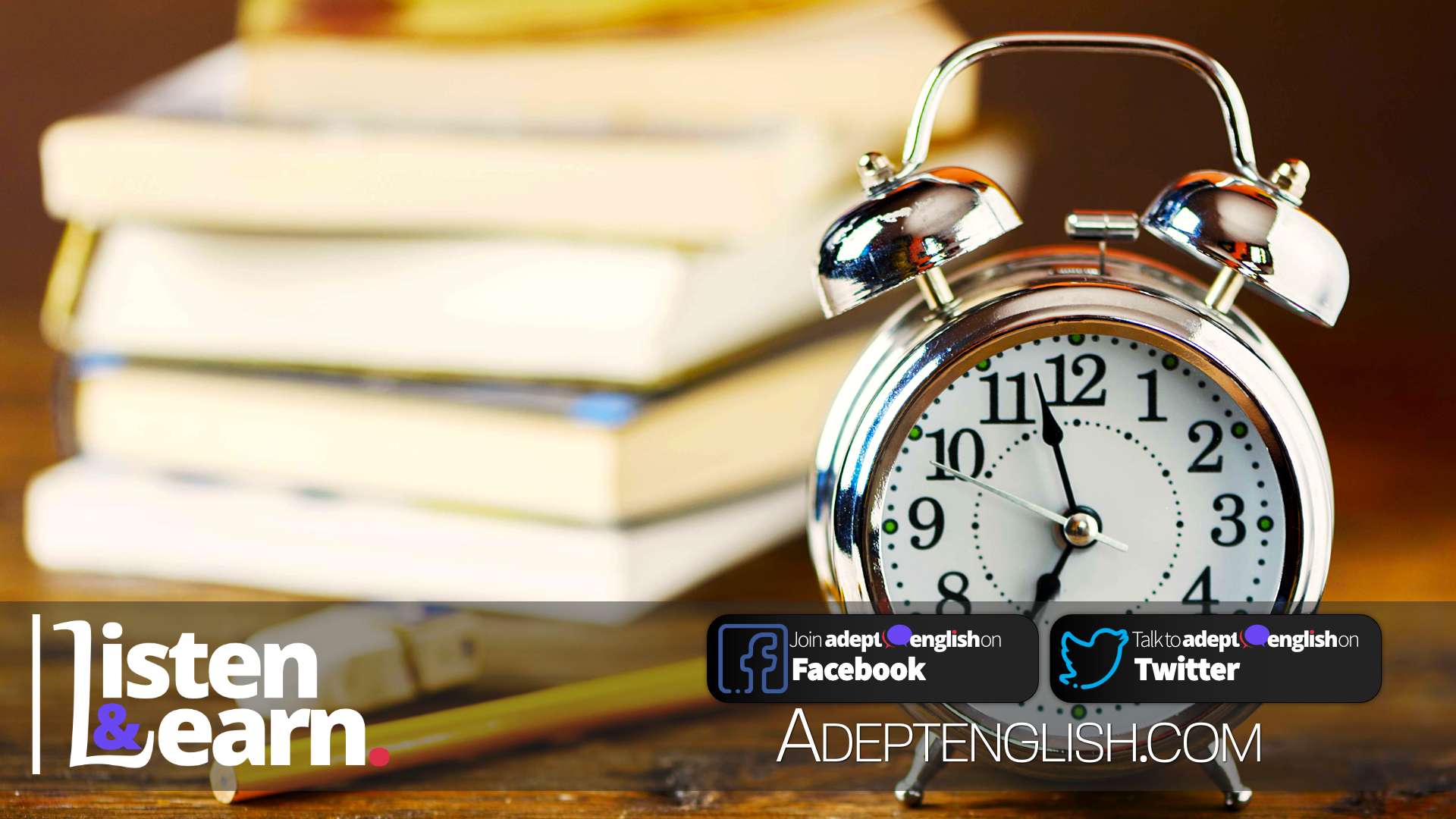Common English Words Used In Telling Time In British English
Time waits for no-one. Time is money. Time is something we all talk about constantly, we use it all the time (pun intended!) in everyday life. As always, native English speakers use shortcut phrases when talking about specific time scenarios, common English words which describe obvious times of the day which are worth knowing. So today's podcast we are going to practice our use of English time vocabulary for both digital times and analogue times.
Breakfast time in the UK is typically between 7am and 9am, but do you know what the (am) stands for? Lunch is usually between twelve and one thirty pm. Did you notice I switched to using twelve, but I didn’t specify at night or midday, because the context suggested lunch, oh and I used (pm).
Notice how flexible and variable the use of time is, it can get a lot more complicated even in everyday conversations. Across the UK native English speakers have variations on the meaning of the same words, so dinner, which for most of the UK would mean 6pm to 8pm, but for some parts of the UK dinner means lunch, oh and sometimes people call dinner supper!
“My favourite things in life don't cost any money. It's really clear that the most precious resource we all have is time.”
▪️ Steve Jobs, Fmr. CEO Apple
So today we tackle talking about the time in British English, with examples, and then cover talking about time while using British English colloquialism. I’d better get a move on I need to finish this by noon, or should I say midday, or maybe twelve o’clock!
Most Unusual Words:
Booking
Nicole
Thankyou
Timetables
Most common 3 word phrases:
| Phrase | Count |
|---|---|
| Telling The Time | 15 |
| O’Clock In The | 6 |
| 24 Hour Clock | 5 |
| We Might Say | 5 |
Listen To The Audio Lesson Now
The mp3 audio and pdf transcript for this lesson is now part of the Adept English back catalogue . You can still download and listen to this lesson as part of one of our podcast bundles.Transcript: Learn The Common English Words Used To Tell The Time In British English
Hi and welcome to this latest podcast from Adept English. We are Adept English and our job is to help you learn English. If you want to learn more about the process of learning a language using our ‘Listen & Learn’ technique, then go to our website and sign up for our course The Seven Rules of Adept English.
Boost Your Learning With Adept English
The knowledge, the advice and learning from that course is useful whichever language you’re trying to learn. But of course we’re hoping you’ll learn English with us. Go to adeptenglish.com and sign up for this free course straight away, if you’ve not done it already.
Telling the time in English
What about telling the time in English? We had that request recently from Nicole who is using Adept English to learn English – so thankyou, Nicole for that suggestion. How about today we do a bit of work on telling the time?
So basically in English there are two ways. One way matches the analogue clock and the other way matches the digital clock. Let’s do the old-fashioned analogue way first. Analogue, A-N-A-L-O-G-U-E is where time is represented on a round clock, with numbers 1 to 12. 12 is at the top and then the numbers go round clockwise, 1 through all the way to 12. And there are two hands, a long hand and a short hand which point at the time.
On the other hand a digital clock means four numbers, usually with a divider like a colon : in between. So 14:00 hours or 04:30 would be examples of times on a digital clock. If I was to make a general rule – the analogue way of telling the time is what we use on the whole in spoken English, informally and in conversation. And the digital way of telling the time, that’s D-I-G-I-T-A-L is more official, more for written English – more what you’d use for a train time, a booking – booking a meeting room or in any written or digital communication.
Telling the time the analogue way
So if we go with the analogue way of telling the time first – if it’s ‘on the hour’ as we say, then that means that the time will be one o’clock’, two o’clock, three o’clock etc. And that ‘o‘clock’ which is short for ‘of the clock’ is spelt O-’-C-L-O-C-K. If we’re asked the time and it’s an ‘o’clock’ we might also just say ‘Oh, it’s 3.’ Or ‘It’s just after 11’, but we also may say ‘Oh it’s 11 o’clock’.
The rest of the hour is divided into five minute periods, five minute chunks of time. So if it’s 5 o’clock, then five minutes later you would say that it’s ‘5 past 5’ – meaning ‘it’s now five minutes past five o’clock’. Ten minutes after 5 o’clock, you would say ‘It’s 10 past 5’. And fifteen minutes after five o’clock, we would say ‘It’s quarter past 5’.
So that one’s a bit different. A ‘quarter’, Q-U-A-R-T-E-R is what you get if you divide something into 4. So here 60 minutes in an hour is divided into quarters, so 15 minutes past the hour called ‘quarter past’. Twenty minutes after 5 o’clock you’d say ‘It’s 20 past 5’, then you could have ‘It’s 25 past 5’ – and finally if it’s 30 minutes after 5 o’clock, we’d say ‘It’s half past 5’. Meaning of course ‘It’s half an hour past 5 o’clock’. Once it’s after half past the hour and we’re using this analogue clock way to talk about the time, then we start saying it’s so many minutes TO the hour.
So in this case, if the big hand of the clock is travelling up the left hand side, if it was 35 minutes past 5 o’clock, we would say ‘It’s 25 to 6’, and five minutes later it would be ‘20 to 6’ and so on. Of course, if it’s 45 minutes past 5 o’clock, then we’d say ‘It’s quarter to 6’, to mirror saying ‘It’s quarter past 5’.
It’s like in French you’d say ‘deux heures moins le quart’ for ‘quarter to 2’ or in German you’d say ‘Viertel vor zwei’ – it’s the same idea. Then of course it goes ‘10 to 6’, which is ten minutes before 6 o’clock and then ‘5 to 6’ meaning it’s five minutes before 6 o’clock. And then of course, we get to the next o’clock and it begins all over again.
Video
Now obviously this analogue way of showing and talking about time is only a 12 hour clock. So if we’re using this analogue method to talk about time, we might add ‘10 past 5 in the morning’. So that would mean early morning. Or we might say ‘10 past 5’ in the afternoon.
Or ‘25 to 12’ at night. So we add a time phrase sometimes to show which 5 o’clock or which 12 o’clock we mean. We also use expressions like 12 midday, that’s M-I-D-D-A-Y or 12 noon, N-O-O-N – to indicate 12 o’clock in the day time, or we might say 12 midnight, that’s M-I-D-N-I-G-H-T to mean 12 o’clock at night.
Other expressions we might use? Well, the time isn’t always exactly on the five minute divisions of the hour. So we might say something like ‘It’s just gone 5 o’clock’ meaning it’s between 5 o’clock and ‘5 past 5’. Or we could say ‘It’s nearly 10 to 2’ meaning it’s perhaps 12 or 13 minutes before two. We might say ‘It’s 13 minutes to 2’ – you...you might hear that as a ‘time check’ on a news channel or on a radio programme, but in conversation we probably wouldn’t be that exact.
We’d say ‘It’s nearly 10 to 2’. So ‘It’s nearly’ or ‘It’s just coming up to’ and then ‘10 to 2’ means it’s just before. And we might say ‘just after’ or ‘just gone 10 to 2’ means it’s just past, it’s a few minutes after. It’s interesting – I’m just noticing that in doing the transcript for this podcast, I’m having to write ‘10 to 2’ – and I’ve never actually done that before. So this shows just how much this way of telling the time is a spoken, something we do in speech, rather than in written English.
Telling the time the digital way
So the digital way of telling the time? Well, you might hear this in spoken English too where the time needs to be very precise, but usually it’s reserved for booking things or for writing down times. Even in an informal email to someone, if you’re talking about time, you would use the digital clock. And it’s really simple.
In the example of 5 o’clock in analogue time telling, which I used before, here you would simply say 5 and then 5:05, 5:10, 5:15, 5:20 all the way around the hour until 5:55, then 6, meaning six o’clock and the 6 would be written ‘6:00’. Usually again time is divided into five minute sections, but if you want to say ‘Oh, it’s 5:46’ or ‘It’s ‘5:47’ that’s OK too. On train or bus timetables, you’ll find the time written like this.
The 24 hour clock in English
If it’s a military operation, or you’re logging a report for a police investigation, you might say ‘O-six-hundred hours’, so ‘06:00’, say for six o’clock in the morning and you might say ‘eighteen hundred hours’ for six o’clock in the evening. So of course, here you’re using the 24 hour clock instead of the 12 hour clock. So you can talk about the time like this using the 24 hour clock, but it’s much more used when written. Or as I say, if you’re involved in a military or a police operation.
📷
A photograph of a yellow digital alarmclock, which is displaying the time using a 24 hour clock.
So if you’re using a 24 hour clock, then 5 o’clock in the morning, the early morning is ‘O-five hundred hours’ and written ‘05:00’ and five o’clock in the afternoon is ‘seventeen hundred hours’ and written ‘17:00’. And if it was ‘5 past 5’ in the afternoon, that’d be said as ‘seventeen-O-five’, written ‘17:05’. And ‘10 past 5’ in the afternoon would be said as ‘seventeen ten’ and written ‘17:10’. So as I said that sounds very ‘official’ and formal. If a friend said to you ‘Right, we’re going shopping at 09:00 hours precisely’, they’d be having a bit of a joke – because they’d be making the shopping trip sound serious, like a military operation. British people find humour in all kinds of things.
Telling the time in English – AM and PM
Another way of representing the 24 hour clock and the fact that each time occurs twice a day – we use AM and PM. These stand for ‘ante meridiem’ and ‘post meridiem’ which are both Latin phrases. So ‘meridiem’ literally means in Latin ‘middle of the day’ so that’s 12 midday or 12 noon. So AM means ‘before the middle of the day’ and PM means ‘after the middle of the day’.
So AM means between 12 midnight – the time at which the new day begins and the date turns – and 12 midday. And PM runs between 12 midday and 12 midnight so is the second half of the day. So 5pm means five o’clock in the afternoon and 5am means five o’clock - early in the morning. So AM and PM are something we use all the time.
Download The Podcast Audio & Transcript
So in conclusion – three ways of representing time
So 05:30 is the same as 5:30am and is the same as ‘half past 5 in the morning’. And 18:45 is the same as 6:45pm or ‘quarter to 7 in the evening’. And where there’s a cross-over between the digital and the analogue? Say you’re discussing on Whatsapp with friends what time you’re going to meet up, you might say ‘Let’s do 3pm’ and that’s written with the number 3-P-M. So we’d probably say ‘three o’clock’, but we’d write 3pm. We like freedom of expression and variety, so English is not always consistent and telling the time is no exception!
Do you want more practice telling the time in English?
Now it’s your turn to give me some feedback. Is this really easy? Or are you thinking ‘Great, this is handy, I could do with some more practice at these different ways of telling the time in English’. Unless you tell us, we don’t know – so send us your feedback. Do you want a podcast to help you practise these different ways of telling the time? As ever email us at adeptenglish.com or leave us a comment on YouTube!
Goodbye
Enough for now. Have a lovely day. Speak to you again soon. Goodbye.










